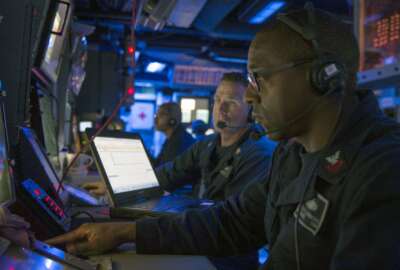
Navy working on digital blueprint as framework to connect components for future tech
The Navy is working on a way to standardize the way it handles data for different scenarios.
The Navy is developing a digital blueprint, expected to be released in December, which will act as a “North Star” for the service in terms of connecting and integrating systems, according to a top Navy research official.
William Bray, deputy assistant Navy secretary for research, development, test and evaluation, said the blueprint is important because the service cannot be completely prescriptive in where the digital world will go, but there are certain standards that need to be implemented to keep alignment within the force.
The blueprint will lay out a broad architecture detailing the systems over all the domains the Navy needs to work across, and then let each piece do its job while remaining integrated to its larger whole and connecting with other services.
Bray said it comes down to how the Navy moves and shares data.
“The digital blueprint should lay out where we are at, where we are going and were we need to go,” Bray said at an American Society of Naval Engineers event in Arlington, Virginia. “I liken it to city planning. You have different sectors. You have an industrial base, you have the urban environment, you’ve got recreational areas, you’ve got a big football stadium. They all need plumbing and electricity. They all want to have it sent the same way, but the demand signal may be very, very different.”
Bray said the tactical world is similar. The time required to move data and the size of the data will change over time and based on operations.
“We need to build in that flexibility,” Bray said. “We need to give that to the program managers to be able to understand. We need to give that to industry so they understand, and we need industry to go off and figure out how to solve that problem. How do we bring the capability and the technologies to the table to solve those different problems.”
The Navy has been working on the blueprint for the past six months. It is a collaboration between the service’s recently set up cross functional team for naval architecture, the Distributed Integration Support Cell and the Digital Warfare Office.
Those organizations bring together the community of program offices, systems commands, the chief of naval operations office and the warfighter to lay out the blueprint.
The blueprint is an operational plan for the Navy’s larger aim to transform the way it uses data for things like artificial intelligence and machine learning across domains and services.
The service is in the process of rolling out a handful of plans around data concepts and implementation.
“The idea here is we are going to start using our data to make decisions, and then we are using our data to prove the decisions we made were sound,” Thomas Sasala, Navy chief data officer, said in October.
The Navy already reorganized its chief information officer position to encompass a broader view over the service and the Marine Corps.
The revamped CIO positions falls directly below the Navy secretary and undersecretary. Below that, a special assistant oversees four new directorates led by four other new senior officials: a chief technology officer, a chief data officer, a chief digital strategy officer and a chief information security officer.
The CIO now plays a larger role in strategy and connecting parts of the services together through IT, cyber and data.
The Navy isn’t the only service changing how it approaches data and the connection between components to make warfare more effective.
The Air Force is also changing its strategy to improve lines of communication so its pieces can work faster together with new technologies.
It unveiled a digital plan in August to unfetter it from an industrialized way of thinking, open itself to faster networks, better weapons systems and make the service a more attractive employer.
“We’ve been very successful so far with the American military and the individual weapons platforms,” then-acting Air Force Secretary Matt Donovan said when the plan was unveiled. “The problem is these exquisite capabilities are largely unconnected from each other. We need to get to a point where we have a family of systems and everything is connected for command and control. We are ultimately trying to get to a point where any sensor will provide information to any shooter.”
Copyright © 2024 Federal News Network. All rights reserved. This website is not intended for users located within the European Economic Area.
Scott Maucione is a defense reporter for Federal News Network and reports on human capital, workforce and the Defense Department at-large.
Follow @smaucioneWFED





